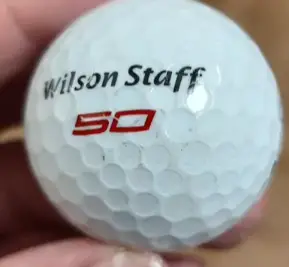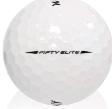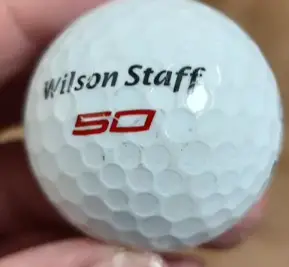Hey, you! If you’re hunting for a golf ball that delivers solid performance without breaking the bank, let me introduce you to the Wilson Staff Fifty Elite. As a mid-handicap golfer who loves a good deal, I’ve spent countless rounds testing these balls, and I’m here to share why they’re worth your attention. With a soft feel, surprising distance, and a price that’s hard to beat, the Wilson Elite 50 could be your new go-to. Let’s dive into my experience, break down the pros and cons, compare it to other brands, and share tips to maximize its potential.
My Experience With The Wilson Elite 50: A Real Golfer’s Take

I’m no pro, but I’ve been swinging clubs long enough to know what works for my game. As a mid-handicap golfer with a swing speed hovering around 90 mph, I’m always on the lookout for gear that balances performance and affordability. The Wilson Elite 50 caught my eye at a local shop, priced at just $9.50 per dozen on clearance—a steal compared to premium balls like Titleist Pro V1s. I decided to give them a whirl during a few rounds at my home course, a windy par-72 layout with tight fairways and tricky greens.
From the first tee shot, I was impressed. The ball felt soft off my driver, almost like a premium ball, but with a satisfying pop that sent it sailing straighter than I expected. Around the greens, it didn’t spin like a tour-level ball, but it held its own for chip shots and putts. Over three rounds in varying conditions—cool mornings, warm afternoons, and even a drizzly day—I put the Elite 50 through its paces. Here’s what I learned, broken down into pros, cons, and how it stacks up against the competition.
Pros Of The Wilson Elite 50: Why I Keep Coming Back
Read More: My Thought on Callaway Edge Vs. Mavrik
The Wilson Elite 50 surprised me in ways I didn’t expect from a budget ball. Here are the standout features that make it a winner in my book:
- Affordable Price Point: At under $15 per dozen, these balls are a bargain. You can stock up without wincing at the cost of losing a few in the water.
- Soft Feel for Slower Swings: With a 50 compression rating, they’re perfect for golfers like me with moderate swing speeds (85-95 mph). The ball compresses easily, giving a cushioned feel off the clubface.
- Impressive Distance: The advanced rubber core delivers surprising yardage. I gained about 5-10 yards on my drives compared to older budget balls I’ve tried.
- Straight Flight Path: The 302 dimple pattern keeps the ball stable, reducing hooks and slices. My drives stayed closer to the fairway, even on off-center hits.
- Decent Greenside Control: While not a high-spin ball, it offers enough stopping power for chip shots. I could land it near the pin and expect a controlled roll.
- Great Putting Alignment: The bold black “Fifty Elite” alignment line is a game-changer. It’s as wide as a Sharpie mark, making it easy to line up putts accurately.
- Durability for the Price: These balls held up well, even after bunker shots. I played 18 holes with one ball and only saw minor scuff marks.
- Color Options: Available in white, yellow, and orange, they’re easy to spot. The yellow ones were a lifesaver in the rough on cloudy days.
- Ideal for Beginners: New golfers will love the forgiving nature and low cost. It’s a ball that won’t punish you for mishits.
- Consistent Performance: From cool 45°F mornings to warm 80°F afternoons, the ball performed reliably across temperatures, which is key for my Canadian golf season.
The affordability is what initially drew me in, but the soft feel and straight flight kept me hooked. I’m not chasing tour-level spin, so the Elite 50’s balance of distance and control felt tailored to my game. The alignment line was a pleasant surprise—I sank more putts just because I could trust my setup. For golfers who want performance without the premium price tag, these balls deliver.
Cons Of The Wilson Elite 50: Where It Falls Short
No golf ball is perfect, and the Elite 50 has its limitations. Here’s what I noticed after testing it:

- Limited Greenside Spin: The ionomer cover doesn’t generate much spin. My approach shots often rolled out more than I wanted, especially on firm greens.
- Not for Fast Swingers: If your swing speed exceeds 100 mph, you’ll overcompress the ball, losing distance and control. It’s designed for slower swings.
- Firm Feel on Full Shots: While soft off wedges, it feels a bit doughy on driver and iron shots. It’s not bad, but it lacks the crispness of premium balls.
- Average Durability: After a few rounds, scuff marks appeared, especially after bunker shots. They’re durable for the price, but not indestructible.
- Lower Spin Off Irons: I noticed less stopping power with mid-irons. The ball carried well but often ran past the pin on longer approaches.
- Not a Premium Performer: Don’t expect Titleist-level control or spin. It’s a value ball, so it can’t compete with tour-grade models.
- Putting Requires Adjustment: The soft feel on putts demands a firmer stroke. I had to hit putts harder to reach the hole, which took some getting used to.
- Limited Workability: Shaping shots is tough. I couldn’t get much draw or fade, which frustrated me on doglegs.
- Less Feedback on Mishits: Off-center hits feel mushy, making it harder to gauge how poorly you struck the ball.
- Availability Issues: Finding them in stock can be tricky. Some retailers only carry them sporadically, which is a hassle if you love them.
The biggest drawback for me was the lack of greenside spin. On fast greens, I struggled to stop the ball close to the pin, which cost me a few strokes. If you’re a high-handicap golfer or just starting out, these cons might not bother you, but better players may want more control.
Comparison With Other Brands: Wilson Elite 50 Vs. Competitors
Read More: My Thought on Callaway Edge Vs. Mavrik
To see how the Elite 50 stacks up, I compared it to popular balls in similar price ranges and a few premium options. Here’s how it fares:
- Wilson Elite 50 vs. Callaway Supersoft:
- The Supersoft (35 compression) feels softer and offers better greenside control.
- Elite 50 is slightly longer off the tee for my swing speed.
- Supersoft’s HEX aerodynamics reduce drag better, but it’s pricier ($25/dozen).
- Elite 50’s alignment line is clearer than Supersoft’s.
- Callaway’s cover is more durable, showing fewer scuffs.
- Supersoft suits slower swings better but feels less responsive on irons.
- Elite 50 wins on price, making it a better value for beginners.
- Callaway offers more color options, including matte finishes.
- Supersoft spins slightly more around greens, which I preferred for chips.
- Elite 50 is more consistent in cold weather.
- Wilson Elite 50 vs. Srixon Soft Feel:
- Srixon’s Soft Feel (60 compression) feels crisper on full shots.
- Elite 50 is longer for slower swingers due to its lower compression.
- Srixon’s 338 dimple pattern enhances flight stability slightly more.
- Elite 50’s alignment aid is superior for putting.
- Srixon is pricier ($22/dozen) but offers better durability.
- Soft Feel provides more spin on approach shots, which I noticed on 7-irons.
- Elite 50 feels softer on putts, which some might prefer.
- Srixon’s cover is less prone to scuffing after bunker play.
- Elite 50 is better for high-handicappers due to its forgiving nature.
- Srixon feels more premium but doesn’t justify the price difference for me.
- Wilson Elite 50 vs. Titleist Velocity:
- Velocity (65 compression) is designed for distance, outpacing Elite 50 by 5-10 yards.
- Elite 50 feels softer and is easier to control around greens.
- Titleist’s 328 dimple pattern promotes a higher trajectory.
- Elite 50’s alignment line is more pronounced than Velocity’s.
- Velocity costs more ($30/dozen), which feels steep for a distance ball.
- Elite 50 is more forgiving on mishits, ideal for inconsistent swings.
- Titleist’s cover is more durable but feels firmer.
- Velocity spins less on short shots, similar to Elite 50.
- Elite 50 is a better budget pick for slower swingers.
- Titleist’s brand cachet doesn’t add enough performance for the price.
- Wilson Elite 50 vs. Wilson Duo Soft:
- Duo Soft (40 compression) is the softest ball in Wilson’s lineup, feeling plusher.
- Elite 50 is slightly firmer, offering a bit more distance for my swing.
- Duo Soft’s 362 dimple pattern reduces drag better than Elite 50’s 302.
- Elite 50’s alignment aid is identical, so no edge there.
- Duo Soft costs $20/dozen, a step up from Elite 50’s bargain price.
- Elite 50 feels more responsive on irons, while Duo Soft is mushier.
- Duo Soft spins slightly more around greens, which I liked for flops.
- Elite 50 is more durable, showing fewer scuffs after 18 holes.
- Duo Soft suits ultra-slow swings (under 85 mph) better.
- Elite 50 is the better all-around value for most recreational golfers.
The Elite 50 holds its own against these competitors, especially for the price. If you prioritize spin and control, the Callaway Supersoft or Srixon Soft Feel might edge it out, but for budget-conscious golfers with moderate swings, the Elite 50’s balance of distance, feel, and affordability is tough to beat.
Maintenance And Tips To Get The Most Out Of Your Wilson Elite 50
To make the most of your Wilson Elite 50s, you need to treat them right and play to their strengths. Here’s how I maximize their performance:

- Clean Them Regularly: Dirt and grass stains reduce performance. I wipe them with a damp towel after every hole to keep the dimples clear.
- Store at Room Temperature: Cold balls lose compression. I keep mine in a garage at 60-70°F to maintain their soft feel.
- Use for Appropriate Swing Speeds: These shine for swings under 95 mph. If you swing faster, switch to a higher-compression ball like the Wilson Staff Model.
- Practice Short Game Adjustments: The low spin means more roll. I practice bump-and-run shots to control distance around greens.
- Leverage the Alignment Line: Use the bold “Fifty Elite” line for putting. I spend extra time lining up putts to boost confidence.
- Avoid Overhitting Putts: The soft core requires a firmer stroke. I practice lag putts to dial in distance control.
- Check for Scuffs: Inspect after bunker shots or cart path mishaps. I swap out heavily scuffed balls to maintain performance.
- Pair with Forgiving Clubs: The Elite 50 works best with cavity-back irons and high-MOI drivers. My game improved with a forgiving 7-iron.
- Play in Mild Conditions: They perform best in 50-80°F weather. In extreme cold or heat, I noticed slight distance inconsistencies.
- Stock Up When Available: Since they’re sometimes hard to find, I buy in bulk during sales to ensure a steady supply.
By following these tips, I’ve stretched the Elite 50’s potential. Cleaning them religiously kept the ball flight consistent, and focusing on the alignment line shaved strokes off my putting. If you’re a beginner or budget golfer, these tips will help you get tour-level value from a value ball.
Frequently Asked Questions (Faq)
Yes, they’re great for recreational golfers, especially those with slower swing speeds (under 95 mph). They offer a soft feel, decent distance, and excellent value at under $15/dozen. While they lack the spin of premium balls, their straight flight and durability make them ideal for beginners or budget-conscious players like me.
The Wilson 50 Elite has a compression rating of 50, making it one of the softest balls on the market. This low compression suits slower swing speeds, providing a soft feel and extra distance through better energy transfer at impact.
It depends on your game. For me, the Elite 50 is tops for value and moderate swings. The Wilson Triad offers better spin and control for mid-handicappers, while the Staff Model X is ideal for low-handicappers seeking tour-level performance. The Duo Soft is great for ultra-slow swings.
The Wilson Triad is the easiest to hit straight, thanks to its tri-balanced construction and low dispersion in testing. The Elite 50 is also very forgiving, with its 302 dimple pattern reducing hooks and slices, making it a close second for recreational golfers.
Conclusion: Why You Should Grab The Wilson Elite 50
Read More: My Thought on Callaway Edge Vs. Mavrik
After countless swings, I’m sold on the Wilson Staff Fifty Elite. It’s not a perfect ball, but for under $15 a dozen, it delivers distance, a soft feel, and surprising consistency that rivals pricier options. Whether you’re a beginner or a budget-savvy golfer like me, these balls make the game more fun without draining your wallet. Stock up, hit the course, and enjoy the confidence of a ball that punches above its price. Trust me—you’ll wonder why you ever spent more.

